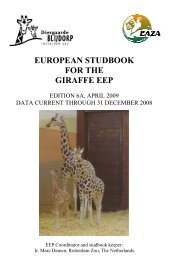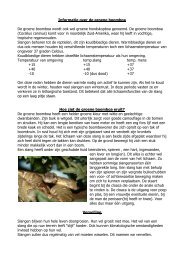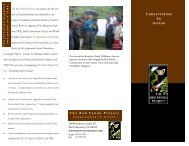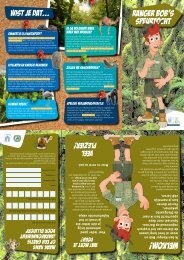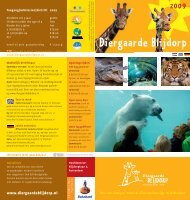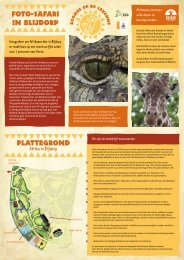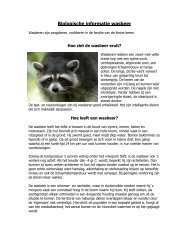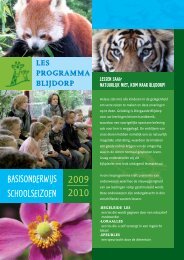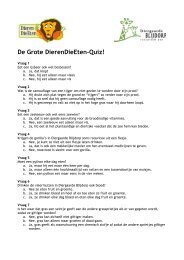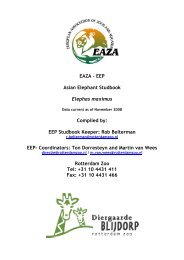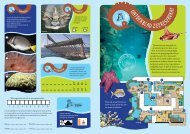Create successful ePaper yourself
Turn your PDF publications into a flip-book with our unique Google optimized e-Paper software.
<strong>EEP</strong> STUDBOOK CROWNED PIGEONS<br />
The three investigated pairs have thick perches available for years and probably their toes are<br />
not very well able anymore to bow and to get grip on the thin perches. To determine the real<br />
preferences perch, a much longer period of investigation is necessary.<br />
In the experiment with substrate in Rotterdam Zoo, the results from the other three pairs could<br />
not be proved. If more parts were covered with sand, the birds spent less time on the perches<br />
and more time on the trunks on the ground. The time spent on the ground did not change<br />
significantly. The hypothesis was that the birds should spend more time on the ground if more<br />
parts were covered with mould. This might also be explained by the long relaxation time to<br />
get used to something new.<br />
It also turned out that if more parts were covered with sand, the crowned <strong>pigeon</strong>s showed<br />
more preening, but also more foraging, which means that they were more active. This might<br />
also prove that the birds have a very long relaxation time.<br />
Conclusions and recommendations<br />
<strong>Crowned</strong> <strong>pigeon</strong>s are not reproducing very well in captivity. Due to a lack of knowledge of<br />
the ecology of crowned <strong>pigeon</strong>s in the wild there is a lot of variation in husbandry in the<br />
different institutions. For that reason it is investigated under which circumstances crowned<br />
<strong>pigeon</strong>s are kept in captivity and if they are reproducing or not.<br />
If Burgers’ Bush is considered to be the most natural situation in captivity, it can be<br />
concluded that a restriction in the variation in the enclosure (and in the freedom to choose for<br />
the animals), leads to an increase in “care”-behaviour: the crowned <strong>pigeon</strong>s spend more time<br />
preening their feathers and so on. If the environment of the birds is even more restricted, the<br />
birds also spend more time conducting metabolic behaviour. Time budget in this case is a<br />
measure for wellbeing.<br />
The enclosure also needs to have as many different elements as possible to enable the birds to<br />
conduct the behaviour they want. From the project into preferences for a type of substrate it<br />
turned out that crowned <strong>pigeon</strong>s needed both sand as well as mould. They use the sand to<br />
conduct “care”-behaviour (preening) and the mould to conduct foraging. If there is no mould<br />
and only sand, they start preening that much, that the plumage gets damaged. By supplying<br />
the birds with some parts of mould (preferably planted), the foraging behaviour increases, the<br />
behaviour in time decreases and the birds are more active and also more attractive to the<br />
visitors, and the enclosure looks more ‘natural’ to the visitors. The mould can be separated<br />
from the sand with use of trunks. If watered regularly the maintenance of the mould does not<br />
cost more time than the sand.<br />
This research project mainly focused on the use of substrate and the preference for a type of<br />
perch. Two out of six <strong>pigeon</strong>s preferred a thick perch. Also changes in substrate did not result<br />
in the expected change in behaviour. One of the major conclusions, which can be drawn from<br />
this experiment, is that crowned <strong>pigeon</strong>s are very susceptible for changes in their<br />
environment. They are used to the daily routine of the keepers, but as soon as something<br />
unexpected happens, like catching other birds or replacing some shrubs, they need several<br />
days or more to behave like they did before. Also the replacement of perches or substrate<br />
caused a lot of stress and it became necessary to wait for days before observing the birds, to<br />
get comparable results. But this still influences the reliability of the results.<br />
111



